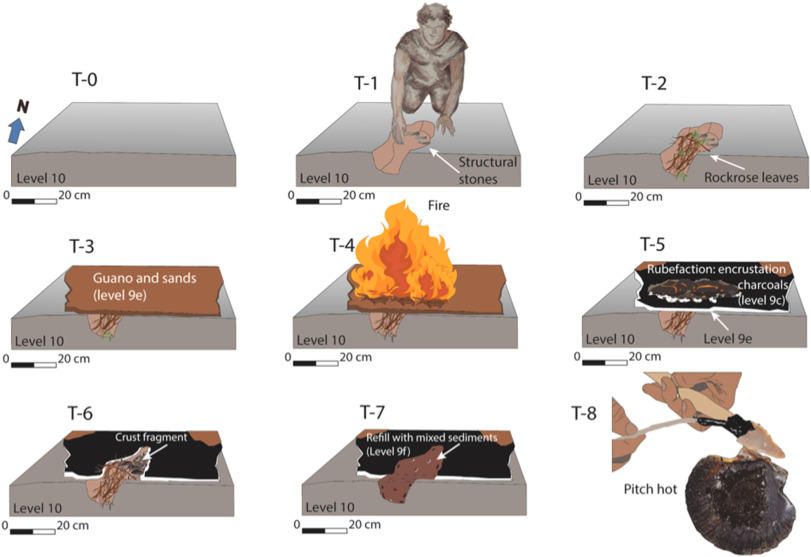For centuries, Neanderthals were often portrayed as primitive, brutish beings. But a new discovery has challenged this long-held stereotype.
A Neanderthal glue-making structure has been uncovered at Vanguard Cave in Gibraltar.
Archaeologists found a specialized hearth or “burning structure,” which they believe was used to create a prehistoric superglue: birch tar.
This discovery provides evidence of their advanced fire-using techniques, suggesting Neanderthals were more intelligent than previously thought.
Advertisement
Advertisement
“Neanderthals were able to construct layered and complex hearths with specific technological objectives that could have included tool, medicine and/or weapon elaboration,” the researchers wrote in the study paper.
The anthropogenic structure could have been made following these steps. Journal Quaternary Science Reviews.
Glue used to make tools and weapons
The discovery was made within a sedimentary layer dated to the period between 60,000 and 67,000 years ago.
“We present multiproxy evidence of a new type of Neanderthal hearth discovered in Vanguard Cave (VC) (Gibraltar), which is dated 65 kyr, and associated with Middle Paleolithic stone artefacts,” the researchers wrote in the study paper.
The location includes several prehistoric human caves. These caves were among the last known homes of Neanderthals in Europe, and before they eventually became extinct.
Advertisement
Advertisement
The researchers suggest that the Neanderthals used the discovered structure for a specific purpose: heating rockrose plants under controlled conditions. To achieve this, they would have burned herbs and shrubs over a layer of guano mixed with sand.
The controlled environment, with limited oxygen, would have been crucial for the process of extracting birch tar from the rockrose plants.
Birch tar, a sticky, dark substance, served as a powerful adhesive, allowing the Neanderthals to craft tools and weapons with precision.
Neanderthals performed complex tasks
The team identified the hearth based on its remains in this seaside cave.
The circular hearth, with its two channels and thick wall lining, deviates from the typical design of cooking fire pits.
Advertisement
Advertisement
More in Science
Moreover, the hearth showed evidence of burning resinous plants, including charred wood and specific plant compounds linked to tar production from birch bark. This suggests a specialized use beyond simple cooking.
The team hypothesizes that the structure was used to heat rockrose plants under controlled conditions.
“We propose that the structure was used for heating rockroses (Cistaceae) under anoxic conditions by burning herbs and shrubs, over a guano mixed with sand layer,” the authors stated.
The researchers built a structure similar to the one found in the archaeological site and attempted to replicate the process of producing birch tar. They successfully produced enough tar from rockrose leaves.
Advertisement
Advertisement
This discovery challenges the long-held stereotype, suggesting Neanderthals were capable of doing intricate tasks. Moreover, they likely had a deep understanding of materials and techniques.
In another recent development, it was found that these prehistoric humans liked collecting marine fossils. Roughly 15 fossils, which seemed to be carefully selected and preserved, were found in Spain cave.
This further bolsters the evidence that Neanderthals were not dim-witted as assumed.
This new study was published in the journal Quaternary Science Reviews.
Abstract
Here we present multiproxy evidence of a new type of Neanderthal hearth discovered in Vanguard Cave (VC) (Gibraltar), which is dated ∼ 65 kyr, and associated with Middle Paleolithic stone artefacts. The hearth structure coincides with predictions from theoretical studies which require the use of heating structures for obtaining birch tar, commonly used in hafting. We propose that the structure was used for heating rockroses (Cistaceae) under anoxic conditions by burning herbs and shrubs, over a guano mixed with sand layer. We tested this hypothesis experimentally with success. The presence of levoglucosan and retene in the structure’s matrix points to combustion of higher resinous plant-derived material. Our results advance our understanding of Neanderthal behavior, as the ability to organize activities related with the use of fire.
EMEA Tribune is not involved in this news article, it is taken from our partners and or from the News Agencies. Copyright and Credit go to the News Agencies, email news@emeatribune.com Follow our WhatsApp verified Channel




